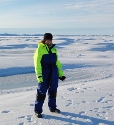Melting Tundra Creating Vast River Of Waste Into Arctic Ocean
January 12, 2010

The increase in temperature in the Arctic has already caused the sea-ice there to melt. According to research conducted by the University of Gothenburg, if the Arctic tundra also melts, vast amounts of organic material will be carried by the rivers straight into the Arctic Ocean, resulting in additional emissions of carbon dioxide.
Several Russian rivers enter the Arctic Ocean particularly in the Laptev Sea north of Siberia. One of the main rivers flowing into the Laptev Sea is the Lena, which in terms of its drainage basin and length is one of the ten largest rivers in the world. The river water carries organic carbon from the tundra, and research from the University of Gothenburg shows that this adds a considerable amount of carbon dioxide to the atmosphere when it is degraded in the coastal waters.
Increased temperatures
The increase in temperature in the Arctic, which has already made an
impact in the form of reduced sea-ice cover during the summer, may
also cause the permafrost to melt. "Large amounts of organic carbon
are currently stored within the permafrost and if this is released
and gets carried by the rivers out into the coastal waters, then it
will result in an increased release of carbon dioxide to the
atmosphere," says Sofia Hjalmarsson, native of Falkenberg and
postgraduate student at the Department of Chemistry.
Study of two areas
In her thesis, Sofia Hjalmarsson has studied the carbon system in
two different geographical areas: partly in the Baltic Sea, the
Kattegat and the Skagerrak, and partly in the coastal waters north
of Siberia (the Laptev Sea, the East Siberian Sea and the Chukchi
Sea). The two areas have in common the fact that they receive large
volumes of river water containing organic carbon and nutrients,
mainly nitrogen.
SOURCE: University of Gothenburg